Los Angeles is a huge city in southern California. It ranks as the second largest city in the United States, after New York City. Few U.S. cities have grown as rapidly as Los Angeles. In 1850, when Los Angeles became a city, it had only 1,610 people. In 1940, with a population of about 11/2 million, it ranked as the nation’s fifth largest city. In 2020, it had nearly 4 million people.
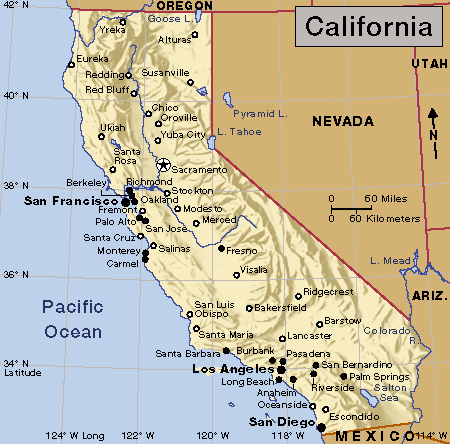
Los Angeles is the seat of Los Angeles County, which is the nation’s largest county in population. The county had about 10 million people in 2020, and it includes dozens of communities in addition to Los Angeles. Los Angeles and Orange counties make up the city’s metropolitan area. Los Angeles and other communities in the area run together and look much alike, making it hard to tell where one ends and another begins. For this reason, the area has been described as “a hundred suburbs in search of a city.”

Many of the people of Los Angeles County moved there from other parts of the United States or from other countries. Many immigrants moved to Los Angeles seeking good jobs or to escape from political conflicts in their countries. Some people were attracted by the city’s scenic location, pleasant climate, and outdoor way of life. Golden beaches line the Pacific Ocean to the west and south, and tall, snow-capped mountains rise to the northeast. The ocean and the mountains help give Los Angeles a mild climate the year around.
Each year, millions of tourists visit the Los Angeles area. They come to enjoy the area’s beaches, ski resorts, and other recreational facilities, as well as its many cultural and entertainment attractions.
Los Angeles is the industrial, financial, and trade center of the western United States. Los Angeles, along with Chicago and New York City, ranks among the leading manufacturing centers in the country. It is among the nation’s leaders in the production of aircraft and equipment for space exploration. The city’s film and television industry is world famous. Banks and other financial institutions in Los Angeles rank among the largest in the country and have helped finance the area’s rapid growth. The Port of Los Angeles is one of the busiest on the West Coast. Each year, thousands of cargo ships, fishing boats, and pleasure craft dock at this port.
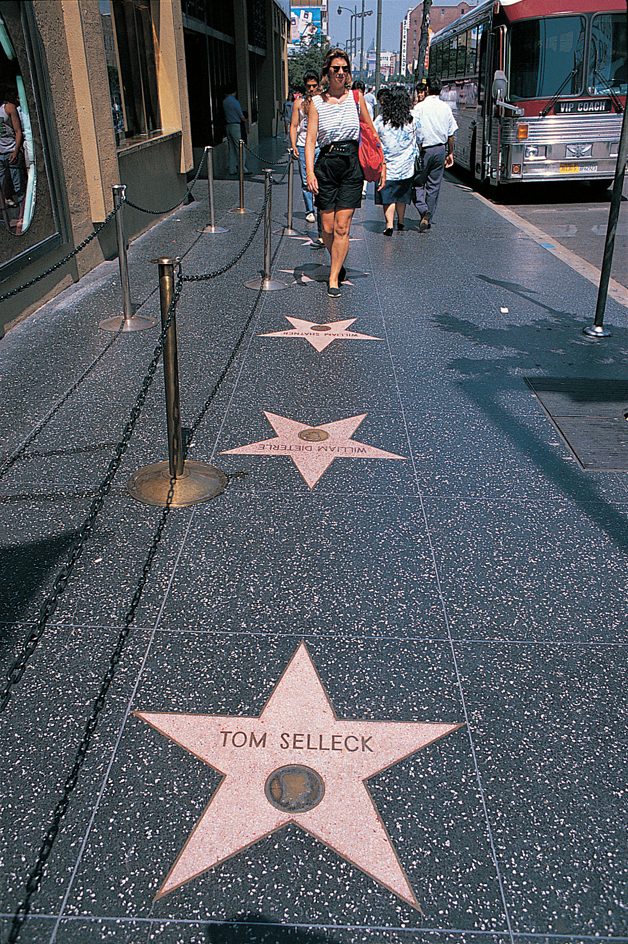
But for all its glories, Los Angeles has serious problems. Earthquakes have caused severe damage. Riots, triggered by racial conflict, have sometimes broken out. Many other problems have resulted from the rapid increase in population. The city has little open land left, and housing—especially low-cost housing—is in short supply. The people depend mainly on automobiles for transportation, and they own millions of cars. The freeways are often jammed, and exhaust fumes and smoke from factories have created serious air pollution. In 1989, California adopted a long-term plan to combat air pollution in the city and surrounding area. To help reduce pollution and traffic jams, Los Angeles has improved its public transportation system.
The city
Los Angeles lies on the Pacific coast in southern California. It is about 350 miles (563 kilometers) southeast of San Francisco and about 130 miles (209 kilometers) northwest of San Diego and the Mexican border. Los Angeles covers 466 square miles (1,207 square kilometers), making it one of the nation’s largest cities in area. It stretches about 50 miles (80 kilometers) from the San Fernando Valley in the north to Los Angeles Harbor at San Pedro Bay in the south. From east to west, the city extends about 30 miles (48 kilometers)—from the San Gabriel Mountains to the Pacific Ocean.
In the past, Los Angeles added to its area by annexing such nearby cities and towns as Hollywood, San Pedro, Van Nuys, and Westwood. These places are now districts of Los Angeles. Los Angeles County includes 87 incorporated cities besides the city of Los Angeles. These communities include the cities of Burbank, Long Beach, Pasadena, and Santa Monica. Beverly Hills, San Fernando, and West Hollywood are independent communities surrounded by Los Angeles.
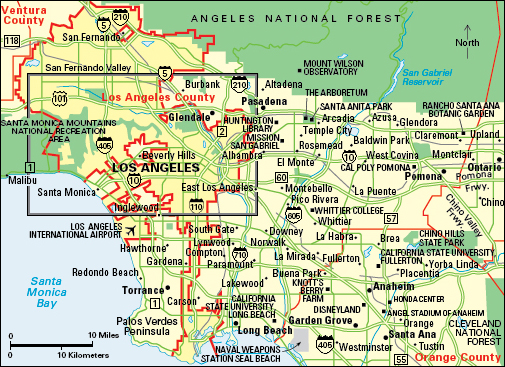
Los Angeles can be divided into eight main sections: (1) Downtown Los Angeles, (2) South Los Angeles, (3) Central Los Angeles, (4) the San Fernando Valley, (5) West Los Angeles, (6) South Bay, (7) the Port of Los Angeles, and (8) East Los Angeles. These sections do not have definite boundaries. They are chiefly areas that have similar types of housing, people with similar backgrounds, or some other common features.

Downtown Los Angeles,
the main business and shopping center, lies near the eastern edge of the city. Los Angeles residents do not depend on their downtown section so much as do the people of other cities. Los Angeles has many commercial and shopping districts because it spreads over a large area.

Los Angeles’s downtown area has changed greatly since 1957. That year, the city government repealed a law that prevented the construction of buildings higher than 150 feet (46 meters), or about 13 stories. The law was originally passed because of the threat of earthquakes. But by 1957, new engineering and construction methods made it possible to construct taller buildings designed to withstand earthquakes. Today, numerous 40- and 50-story buildings rise in the downtown area. The city’s tallest buildings include the 1,018-foot (310-meter) U.S. Bank Tower and the 1,100-foot (335-meter) Wilshire Grand Tower, both of which rise downtown.
City Hall, one of the best-known landmarks in Los Angeles, stands in the downtown area. For many years, this 454-foot (138-meter) structure, with its distinctive white tower, was the city’s tallest building and the only exception to the 150-foot (46-meter) height limit. City Hall is part of a group of city, county, state, and federal buildings that make up the Civic Center. Grand Park, which features a wading fountain, gardens, and gathering spaces, lies just west of City Hall.
At the west end of the Civic Center stands the Music Center. The center, which is part of the Civic Center, consists of the Walt Disney Concert Hall, the Dorothy Chandler Pavilion, and two theaters, the Ahmanson Theatre and the Mark Taper Forum. The center’s programs include concerts, operas, dance performances, and plays. A group of luxury apartment houses called Bunker Hill Towers and several tall office buildings form an impressive skyline in this area. Nearby is the Cathedral of Our Lady of the Angels, a Roman Catholic cathedral whose walls resemble the adobe walls of California’s early Spanish missions. Also nearby is California Plaza, a development that includes two large office buildings, the Museum of Contemporary Art, and the Watercourt, a performing arts plaza. 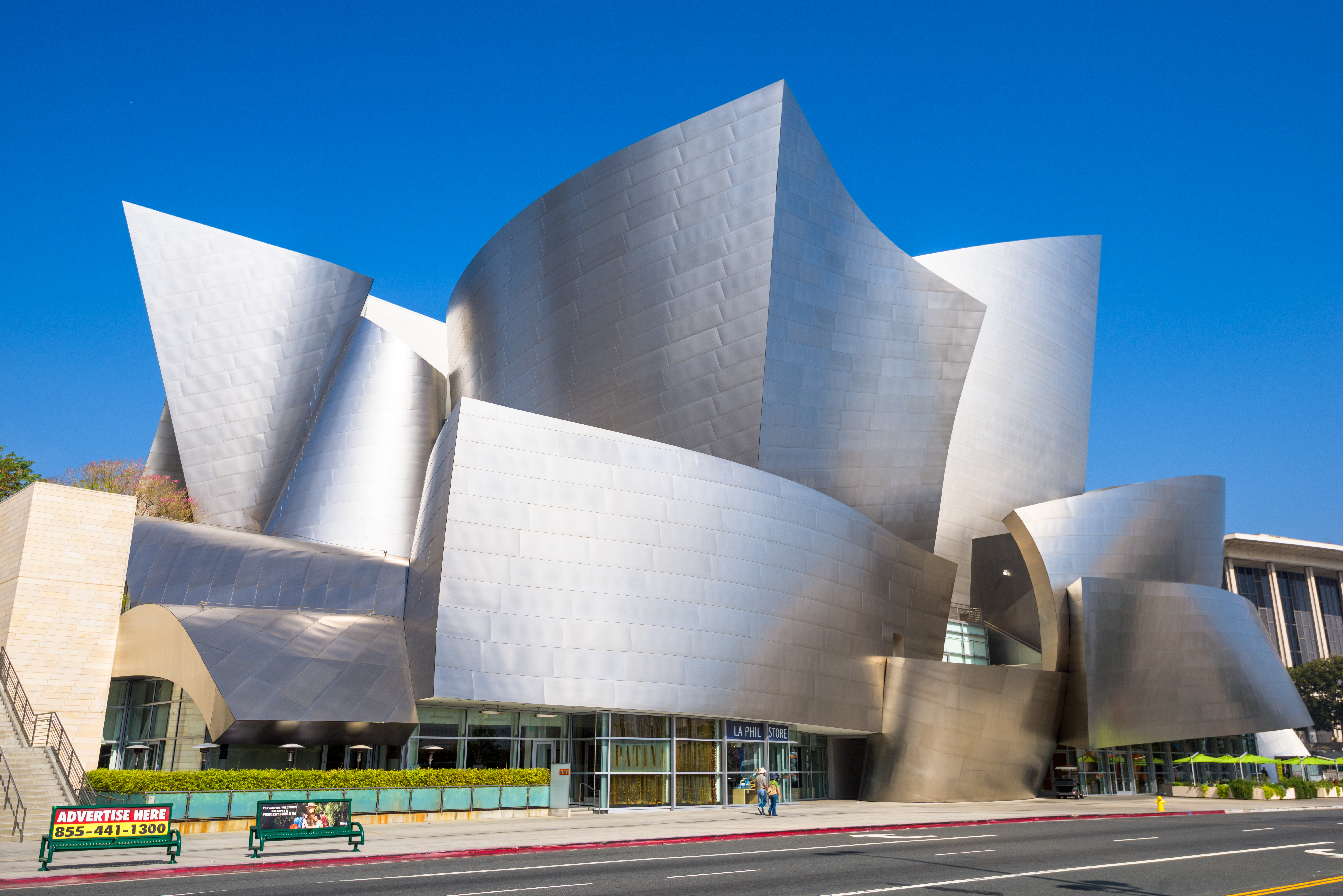
The downtown area also includes some of Los Angeles’s oldest buildings. Northeast of the Civic Center lies an area called the Pueblo de Los Ángeles (Town of the Angels). A group of settlers from Mexico founded Los Angeles there more than 200 years ago. The area has been restored to resemble a village of old Mexico. The Pueblo includes the Old Plaza, a charming public square shaded by 100-year-old magnolia trees. Buildings dating back to the late 1800’s surround the Plaza. Olvera Street, one of Los Angeles’s oldest streets, begins at the Plaza and runs north. Colorful stalls selling Mexican handicrafts line the street. Adobe buildings from the early 1800’s house Mexican craft shops and restaurants.
Three blocks southwest of City Hall lies a Hispanic American shopping district with many restaurants and shops owned by immigrants from Mexico and Central America. Little Tokyo, a Japanese neighborhood, is two blocks southeast of City Hall. This area has many Japanese restaurants, shops that sell goods imported from Japan, art galleries, and food markets. A few blocks north of City Hall lies Chinatown. There, many Chinese American residents operate restaurants and shops that sell antiques, art objects, and souvenirs. Many Korean Americans live in a section called Koreatown southwest of downtown.
South Los Angeles
covers a huge region south of the downtown area. It was long one of the largest Black communities in the United States but is now racially mixed. During World War II (1939-1945), many African Americans moved to South Los Angeles (then called South-Central Los Angeles) to work in war plants. After the war, the city’s Black population continued to increase. The African American community spread south to include a district called Watts, about 10 miles (16 kilometers) from downtown. Watts has become the center of the African American community in Los Angeles. The Black population has also spread west through the independent community of Inglewood. Some Black neighborhoods of South Los Angeles consist of slum housing. But others have expensive homes. Also, thousands of African Americans have moved to the suburbs. Hispanic Americans and people of Asian ancestry now make up more than half the population of South Los Angeles.
Central Los Angeles
lies between the downtown area, on the east, and the independent community of Beverly Hills, on the west. Parts of this area contain a growing number of Asians and other immigrants. A large part of Central Los Angeles consists of Hollywood, a community famous for TV and motion-picture studios. Hollywood Boulevard, one of Los Angeles’s best-known streets, runs through Hollywood’s business district. The names of Hollywood celebrities are engraved on big stars set in the sidewalks along the boulevard and its side streets.

Sunset Boulevard, another famous Los Angeles street, is just south of Hollywood Boulevard. It begins in the downtown area and winds almost 25 miles (40 kilometers) through Central Los Angeles to the Pacific Ocean. The section that runs through the city of West Hollywood is called Sunset Strip, or the Strip. It is lined with smart shops and expensive restaurants and cafes. It is also known for its nightclubs and coffee houses.
Wilshire Boulevard, about 21/2 miles (4 kilometers) south of Sunset Boulevard, also runs from downtown through Central Los Angeles to the ocean. Wilshire Boulevard is known for its tall office buildings and fine shops and department stores. A section of the street called the Wilshire Center is lined with handsome modern buildings.
The San Fernando Valley
lies northwest of Hollywood across the Santa Monica Mountains. The Los Angeles section of the valley covers 234 square miles (606 square kilometers), which the city annexed in 1915. When Los Angeles annexed the section, it consisted of large open areas and several rural communities. Today, huge housing developments and shopping centers cover the San Fernando Valley. Approximately 1 1/2 million people, about 40 percent of Los Angeles’s residents, live in the valley. Most of them live in single-family houses with patios and barbecues in the backyard. Many homes include a backyard swimming pool. The area also has numerous small apartment buildings and high-rise buildings. The independent communities of Burbank, Glendale, and San Fernando also are in the valley. Another valley community, Northridge, was the center of a major earthquake in 1994. 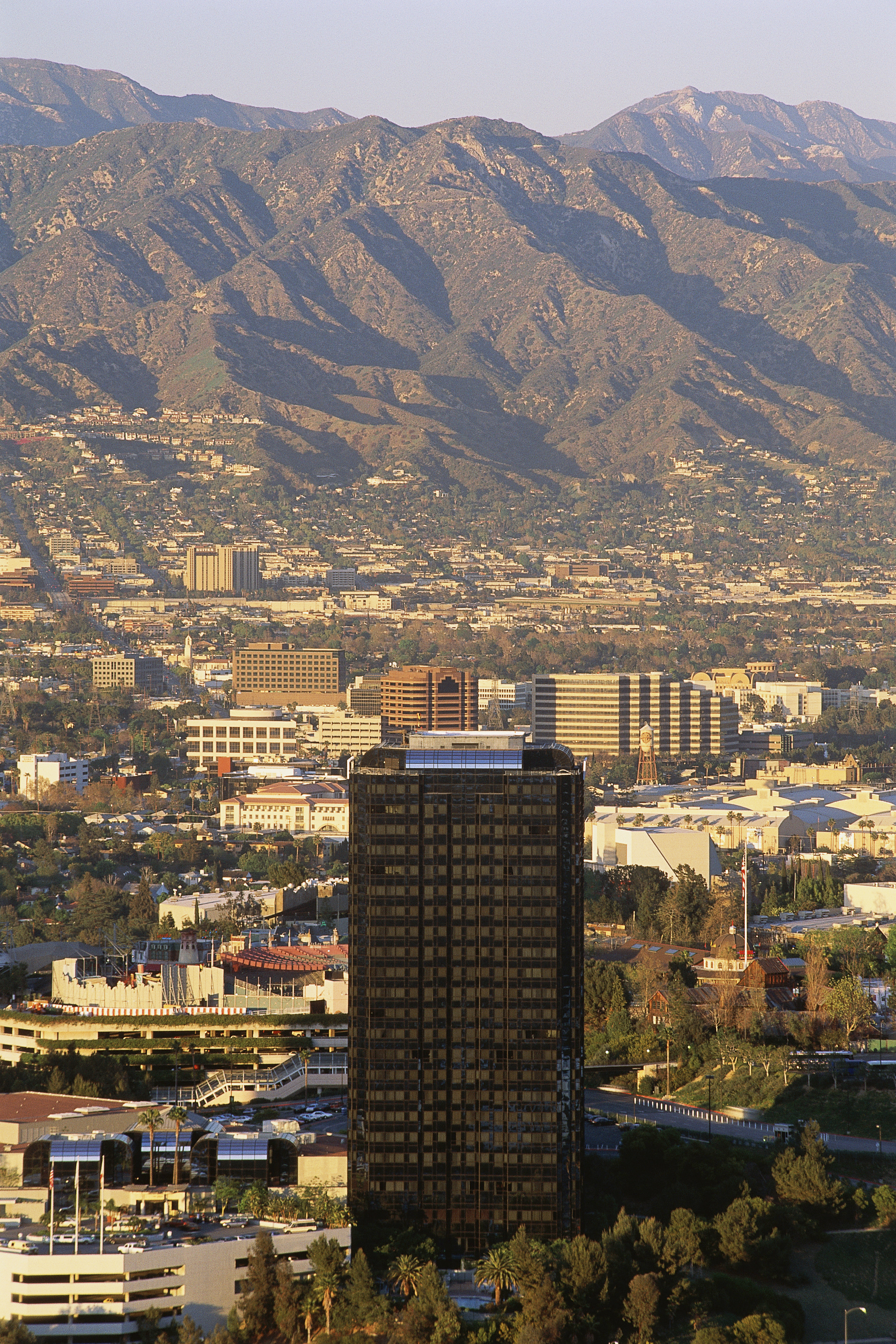
West Los Angeles
occupies the area from Beverly Hills to the city’s western border. The Santa Monica Mountains cover much of West Los Angeles.
Century City, a planned community, borders Beverly Hills on the southwest. This “city within a city” includes office and residential buildings, large hotels, a shopping center, restaurants, and theaters. Century City stands on land that was once part of the Twentieth Century Fox motion-picture studio.
The community of Westwood and the University of California at Los Angeles (UCLA) lie west of Century City. Westwood began in the 1920’s as a small village of Spanish-style buildings. It has grown with the UCLA campus and has become a lively college town, shopping area, and entertainment center.
Three of the city’s most fashionable communities—Bel Air, Brentwood, and Pacific Palisades—are in West Los Angeles at the foot of the Santa Monica Mountains. Bel Air is north of Westwood, and Brentwood and Pacific Palisades are west of it. Pacific Palisades is home to the Will Rogers State Historic Park, which preserves the ranch where the American humorist lived until his death in 1935.
The community of Venice lies between the city of Santa Monica and Marina del Rey, a harbor for small boats. Venice was designed in the early 1900’s as a city of canals like Venice, Italy. Today, most of the canals have been filled in, and the area consists of aging beach homes and hotels, and a few modern apartment buildings.
South Bay
lies along the Pacific Ocean from Marina del Rey south to the Palos Verdes Peninsula. It includes an area of the city of Los Angeles called Playa del Rey, as well as several independent communities. Playa del Rey, south of Marina del Rey, was once a pleasant beach community. Today, it is troubled by noise from Los Angeles International Airport.
The independent communities of El Segundo, Manhattan Beach, Hermosa Beach, and Redondo Beach stretch south along the ocean from Playa del Rey to the Palos Verdes Peninsula. Cities on the peninsula include Palos Verdes Estates and Rolling Hills Estates.
The Port of Los Angeles
is on San Pedro Bay, about 20 miles (32 kilometers) south of the downtown area. It includes the communities of San Pedro and Wilmington. The port area is almost surrounded by independent cities and is connected to South Los Angeles by a narrow strip of land annexed by the city in the early 1900’s. The Port of Los Angeles has one of the world’s largest artificial harbors. It covers about 7,000 acres (2,800 hectares). A breakwater, built between 1899 and 1914, protects both the Los Angeles Harbor and the Long Beach Harbor to the east. The breakwater is 9 miles (14 kilometers) long.
East Los Angeles
lies east of the downtown section. Since the 1920’s, many poor, unskilled immigrants arriving in Los Angeles have settled in this area. East Los Angeles once had a large Jewish population. Since the 1940’s, however, it has been made up almost entirely of Mexican Americans and other Hispanic Americans, and Asian Americans.
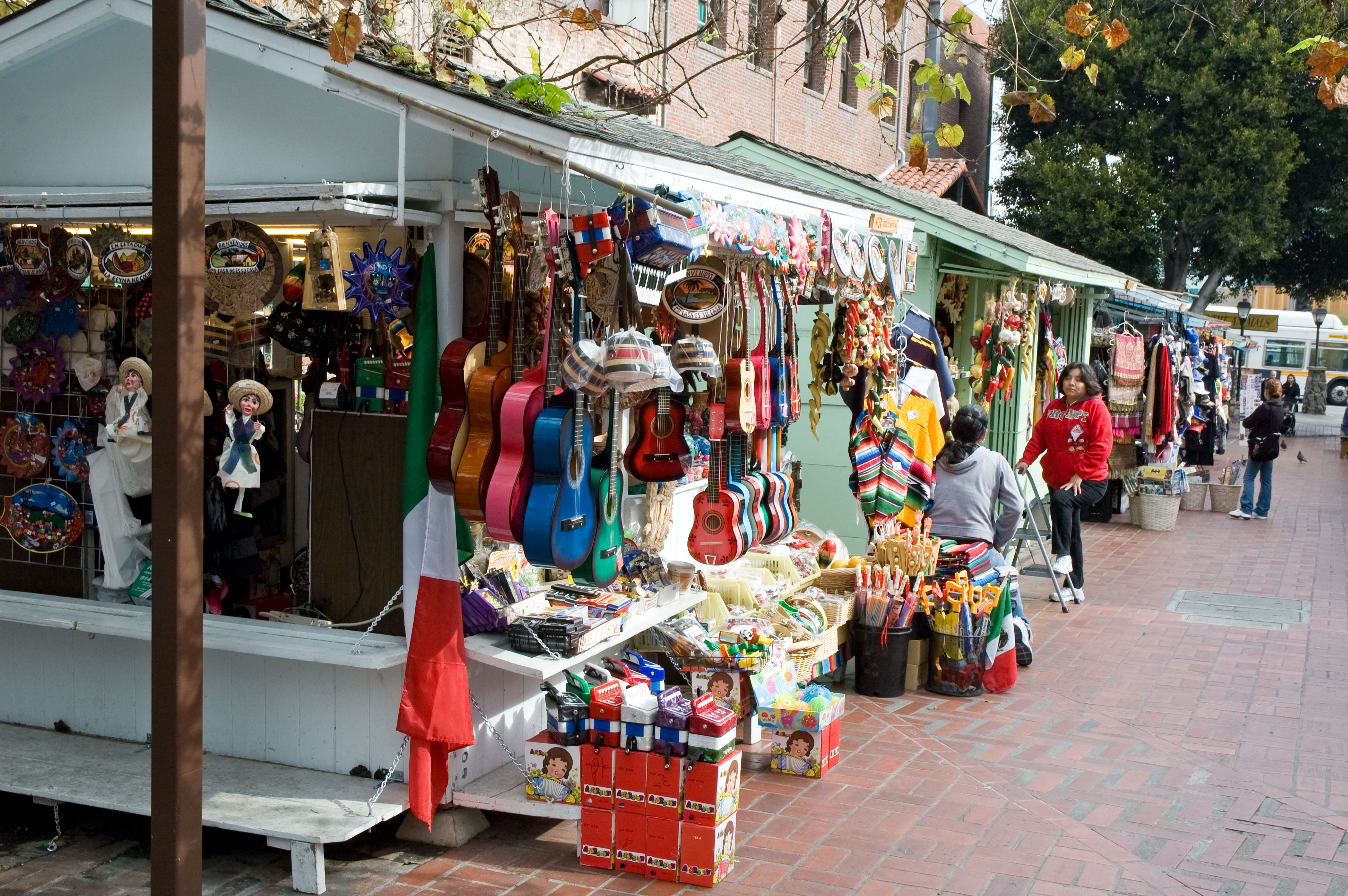
The people who live in East Los Angeles call the area the barrio, a Spanish word for neighborhood. Many of the people call themselves Chicanos. A Chicano is a person of Mexican descent who was born in the United States or who identifies with that group. Other Hispanic people prefer the name Latinos, which means Latin Americans. The barrio extends far beyond the Los Angeles city limits into parts of Los Angeles County that do not belong to any city. The entire area has millions of Hispanic Americans. People of Mexican ancestry make up the largest Hispanic group. Many of these people speak little English. Many of the houses in the barrio are run-down wood-frame cottages built in the 1920’s.
Metropolitan area.
The Los Angeles-Long Beach-Anaheim metropolitan area spreads over Los Angeles and Orange counties. By 2020, it had 13,200,998 people and ranked as the nation’s second largest metropolitan area. According to the United States Census Bureau, only the New York-Newark-Jersey City metropolitan statistical area had more people.
The Census Bureau also defines a metropolitan division, called Los Angeles-Long Beach-Glendale. This metropolitan division consists of Los Angeles County. By 2020, it had a population of 10,014,009.
Many people commute to jobs in Los Angeles from the suburbs of an area known as Greater Los Angeles. This area, which is not defined by the Census Bureau, includes Los Angeles, Orange, Riverside, San Bernardino, and Ventura counties.
The communities in the Los Angeles metropolitan area blend together so that, in many cases, it is difficult to tell one from another. As a result, the entire metropolitan area is often referred to as simply Los Angeles. Many of the famous features and tourist attractions that people from other parts of the country think are in Los Angeles are actually outside the city.
Major suburbs north and east of Los Angeles include Burbank, Glendale, and Pasadena. The Walt Disney and Warner Bros. studios are in Burbank, and NBCUniversal Media, LLC, also has studios there. Glendale includes famous Forest Lawn Memorial Park, an elaborately landscaped cemetery filled with statues and other works of art. Pasadena is known for its Tournament of Roses, held on or near New Year’s Day. The tournament consists of a parade of flower-covered floats, followed by a football game in the Rose Bowl. Each year, two top college football teams compete in the Rose Bowl game.
Beverly Hills, which lies west of Hollywood, is almost completely surrounded by Los Angeles. It is a fashionable community of expensive homes, many of which belong to motion-picture and television stars. Santa Monica, an attractive residential and resort city, lies southwest of Beverly Hills along the Pacific Ocean. It is the site of the RAND Corporation, a research organization that studies defense questions. Culver City, east of Santa Monica, has the Sony Pictures Studios.
The residential towns of Gardena and Torrance lie west of the strip of Los Angeles that connects the Port of Los Angeles with South Los Angeles. The Palos Verdes Peninsula juts into the Pacific Ocean south of Torrance. The city of Long Beach is east of the Port of Los Angeles. Long Beach is also an important port city.
Many residential communities in Orange County lie in the Greater Los Angeles area. They include Anaheim, Buena Park, Garden Grove, Huntington Beach, and Santa Ana. Some of them have well-known tourist attractions. For example, Anaheim is the site of Disneyland Park, a world-famous amusement park. Knott’s Berry Farm, which has a ghost town and a Native American village, is in Buena Park.
People
Through the years, large numbers of people from other parts of the United States and the world have settled in Los Angeles. People of Hispanic, Black, or Asian ancestry make up about two-thirds of the city’s population. Most of the rest of the people are of European ancestry. They include people of English, German, Irish, Italian, and Russian descent. Roman Catholics make up the city’s largest religious group. Other large religious groups include Christian Scientists, Episcopalians, Jews, Lutherans, Methodists, and Muslims.
Ethnic groups.
Hispanic Americans account for nearly 50 percent of Los Angeles’s population. People of Mexican ancestry make up the largest Hispanic group by far. Los Angeles has about 11/4 million Mexican Americans, more than any other U.S. city. Most were born in the United States. But many moved to the city from Mexico in search of higher-paying jobs and a better life. The city’s Hispanic population also includes people from—and descendants of people from—Cuba, Puerto Rico, and the countries of Central America and South America. Many of the city’s Mexican Americans and other Hispanic people live in crowded, run-down barrios in East and South Los Angeles. But there are also barrios in other sections of the city. Discrimination, a lack of education, and the inability to speak English have prevented many Hispanic people from finding well-paying jobs and leaving the barrios.
African Americans make up 8 percent of the population of Los Angeles. The city has about 325,000 Black residents. Most live in South Los Angeles. Many have been prevented from leaving this area by poverty, a lack of education, and discrimination in jobs and housing. But many other African Americans live in integrated parts of the city and its suburbs. In fact, more than 400,000 Black people live in the suburban areas of Los Angeles.
People of Asian ancestry make up over 10 percent of the city’s population—about 455,000 people. The largest Asian groups, in order of size, are Filipinos, Koreans, Chinese, and Japanese. Asians live in various parts of the city, and they have better opportunities for higher education and good jobs than Hispanic and Black people do. However, Asians once had much the same problems of poverty and discrimination that Hispanic and Black people now face.
Housing.
Before the 1960’s, most of the housing in Los Angeles consisted of single-family bungalows, cottages, and ranch-style homes. Land in the area had been plentiful and inexpensive. Developers could buy large sections of land, build hundreds of houses at one time, and sell the homes at low prices. The construction of single-family housing developments reached its peak in the 1940’s and 1950’s. In such areas as the San Fernando Valley, thousands of homes were built on land once covered by orange groves and farms.
By the 1960’s, Los Angeles had little vacant land left—and that land was expensive. In addition, the cost of labor and materials had increased greatly. As a result, the majority of new single-family homes were more expensive than most families could afford. Builders then began to construct more apartment houses.
In 1962, for the first time in the city’s history, more apartments were built than single-family houses. Since 1962, builders have continued to construct more apartments than houses. Many of these buildings have swimming pools, health clubs, and other luxury features.
Education.
Los Angeles has the second largest public school system in the United States. Only New York City’s system is larger. The Los Angeles Unified School District, as the public school system is officially called, extends beyond the city limits. It covers 710 square miles (1,840 square kilometers), an area about 11/2 times as large as the city itself. The district includes hundreds of schools. There are also a large number of private and church-supported schools in Los Angeles.
An elected Board of Education runs Los Angeles’s public school system. The board members appoint a superintendent to serve as chief administrator of the school system.
In the late 1960’s, the Los Angeles school system began to have serious financial problems as enrollments and operating costs increased faster than the system’s income. To save money, class sizes were increased, some teachers discharged, and class hours shortened. In 1970, about half the district’s schoolteachers staged a monthlong strike for higher wages and improved classroom conditions. The teachers accepted a pay raise, though many of them felt the money should be used for classroom improvements. In 1989, more than half the district’s teachers staged a strike that lasted two weeks. Again, the teachers accepted a pay raise.
Before 1978, about 70 percent of the school system’s funds came from taxes on real estate and personal property of district residents. In 1978, voters passed an amendment to the state Constitution cutting property taxes. As a result, the city’s school system now depends on state aid for about 80 percent of its expenses. About 20 percent of the budget still comes from local real estate and personal property taxes.
Los Angeles has many institutions of higher education. The Los Angeles Community College District administers community colleges in and near the city. The colleges offer two-year programs in a variety of subjects. These colleges, formerly called junior colleges, also offer courses that can later be used for credit in senior colleges.
The city’s public universities include the University of California at Los Angeles (UCLA), a branch of the University of California. Los Angeles also is the home of California State University at Los Angeles and California State University at Northridge.
The University of Southern California (USC) is a major private university in Los Angeles. There are many other private universities and colleges in the area. They include Loyola Marymount University, Mount St. Mary’s University, Occidental College, Pepperdine University, and Woodbury University.
Social problems.
The chief social problems in Los Angeles, as in most other large U.S. cities, include poverty, and racial and ethnic conflicts. Los Angeles has one of the highest standards of living of any city in the nation. Yet thousands of Los Angeles’s residents do not share in the wealth. Most of these people are African Americans who live in the ghettos of South Los Angeles and Mexican and other Hispanic Americans who live in the barrios of East Los Angeles and other parts of the city. The city’s poor also include thousands of homeless people, many of whom live downtown.
The people of the ghettos and barrios live in run-down, overcrowded homes and have little education. Many have difficulty finding work, and others have low-paying jobs. A large number of students quit school. Crime is widespread, and many young people belong to gangs that engage in criminal activity. In the barrios, many people speak only Spanish. This limits their opportunities for jobs and education.
Conditions in the ghettos and barrios of Los Angeles have led to serious riots. In 1965, riots raged in the majority-Black Watts district of South Los Angeles (then called South-Central Los Angeles) for five days. The rioting resulted in 34 deaths and about $40 million in property damage. In 1992, a more widespread riot in the same area and other parts of the city caused 53 deaths and more than $1 billion in damage.
In the 1980’s, there was a large increase in the amount of crime committed by members of gangs in Los Angeles. Much of the crime, which has continued, has been related to the buying and selling of illegal drugs. Many people have been killed in the violence. 
The local, state, and federal governments have taken action to help Black and Hispanic Americans in Los Angeles. Job-training courses have been set up to teach unskilled workers. Spanish-speaking teachers have been assigned to barrio schools, and Black and Hispanic studies have been introduced in ghetto and barrio schools. Thousands of students have been bused out of these crowded schools into suburban schools. Legal aid programs have been set up to help minority group members who feel they have been discriminated against in seeking a job or a place to live. But progress has been slow, partly because poor, unskilled people—including many illegal immigrants—have continued to pour into the overcrowded ghettos and barrios.
Economy
Los Angeles ranks as the most important center of industry, trade, and finance in the western United States. The city’s economy, like its population, has grown rapidly since World War II. Since the end of the war in 1945, the number of jobs in the Los Angeles area has increased greatly. During this period, a large number of new industries, financial institutions, and trading facilities moved into the area and existing ones expanded.
Industry.
Los Angeles, along with Chicago and New York City, ranks among the largest manufacturing centers of the United States. The Los Angeles area has thousands of factories. Traditionally, aerospace has been one of the area’s chief industries. This industry involves the manufacture of aircraft, spacecraft, and related parts and equipment. The aerospace industry attracted more engineers, mathematicians, scientists, and skilled technicians to Los Angeles than to any other U.S. city. But in the 1990’s, the aerospace industry suffered a major downturn, resulting in numerous factory closings and the loss of thousands of jobs.
Los Angeles—especially the Hollywood district—has long been known as the motion-picture capital of the world. Filmmaking reached its peak in the Los Angeles area in the mid-1940’s. By the late 1940’s, television had begun to attract more and more moviegoers. The studios reduced the number of motion pictures they made and dismissed many employees. In time, the studios became increasingly involved in making films for television. Also, separate network television facilities were built in the Los Angeles area. Today, most TV films are made in Los Angeles and many other TV comedies, dramas, and other shows originate there.
Los Angeles has rich deposits of petroleum, which is pumped from wells scattered throughout the area. The city’s petroleum industry dates back to the late 1800’s, when the first wells were drilled. In addition to producing petroleum, the city ranks as one of the nation’s top oil-refining centers. It is also a major manufacturer of oil-field equipment.
Other important industries in Los Angeles produce a wide range of products. The city is a leading producer of clothing, computers, furniture, rubber, and tires. Other products include chemicals, electric equipment, glassware and pottery, iron and steel, toys, and travel trailers. The construction industry and printing and publishing are also important. The area is also a major center of the music-recording industry and has dozens of record companies.
The Port of Los Angeles was once one of the largest tuna-canning centers in the world. However, foreign competition, U.S. trade policies, and other factors forced many of the port’s tuna canneries to close in the 1980’s and 1990’s. The port’s last major tuna cannery was shut down in 2001.
Trade.
The Port of Los Angeles handles a greater annual value of cargo than any other United States port. This cargo includes foreign imports and exports, as well as goods going to or coming from other United States ports. Most of the trade between the United States and Japan flows through the Port of Los Angeles. The Port of Los Angeles also handles much of the nation’s trade with Australia, Canada, Mexico, South America, and Southeast Asia. Large amounts of domestic and international cargo are also handled at Los Angeles International Airport.

Los Angeles ranks second only to New York City in retail trade. The city also is the West Coast’s chief wholesale distribution center.
Finance.
Los Angeles is the leading financial center on the West Coast. Several major banks and savings and loan associations have their headquarters in the city. Dozens of insurance companies also have their headquarters in Los Angeles.
Tourism.
Millions of tourists come to southern California every year. Most of them visit the Los Angeles area and contribute millions of dollars to the city’s income. The tourist industry supports hotels, motels, and restaurants, as well as facilities for cultural events and recreational activities.
Transportation.
Los Angeles residents depend mainly on automobiles for transportation. The city has one of the world’s most extensive freeway systems. This 670-mile (1,080-kilometer) network of high-speed expressways runs through Los Angeles, Orange, and Ventura counties. The system consists of overpasses, underpasses, and interchanges. During morning and evening rush hours, slow-moving traffic jams the city’s freeway system.
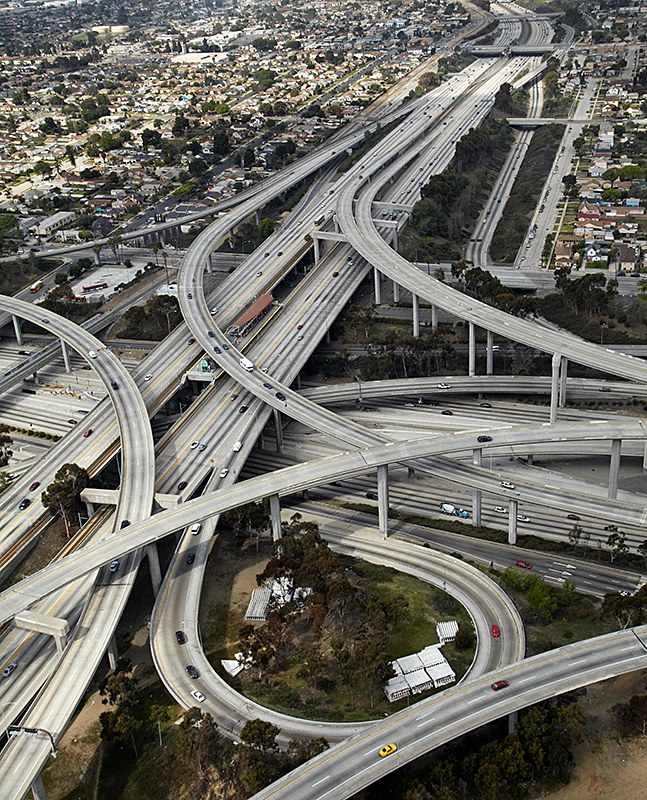
The Los Angeles County Metropolitan Transportation Authority, a public corporation, operates a bus and rail system in Los Angeles. Bus routes run throughout Los Angeles County. The rail system carries passengers to destinations in the city and suburbs. The trains travel through subway tunnels in the central parts of the city and operate at ground level outside the central core. In addition, a separate rail system called Metrolink serves passengers traveling between Los Angeles and surrounding counties.
Two major railroads—the BNSF Railway and the Union Pacific—serve Los Angeles. Trains use the famous Los Angeles Union Station at the eastern edge of the downtown area. This huge railroad terminal was built in the style of California’s early Spanish missions, with a tiled roof and two patios.
Los Angeles International Airport, near Playa del Rey, is one of the world’s busiest airports. Both domestic and foreign airlines use Los Angeles International Airport.

Communication.
Los Angeles has two general daily newspapers, the Los Angeles Daily News and the Los Angeles Times. Dozens of daily, weekly, and semiweekly community and foreign-language newspapers are also published in the Los Angeles area.
In addition, Los Angeles has a number of underground newspapers. These newspapers deal with such matters as civil rights, pollution, and personal and sexual freedom.
Hundreds of magazines, technical publications, and trade journals are published in the Los Angeles area. They include Los Angeles magazine, which features articles of general interest about the area. Many other magazines specialize in single subjects that are popular in the area, such as surfing, hot-rodding, and pottery making.
Dozens of television and radio stations broadcast in the Los Angeles area. Los Angeles is the corporate headquarters of the Fox television network. In addition, three other major networks—ABC, CBS, and NBC—originate many programs from their studios in the area.
Cultural life and recreation
Los Angeles has long been known for its outdoor way of life. The city’s climate and its location along the ocean and near snow-covered mountains enable the people to enjoy most outdoor sports the year around. But over the years, the people of Los Angeles have grown increasingly interested in cultural matters. As a result, Los Angeles today ranks not only as one of the nation’s top recreational centers but also as a leading cultural center.
The arts.
The city’s handsome Music Center symbolizes the city’s cultural leadership. The center, which is part of the Civic Center, consists of the Walt Disney Concert Hall, the Dorothy Chandler Pavilion, and two theaters, the Ahmanson Theatre and the Mark Taper Forum. The Los Angeles Philharmonic orchestra performs in the Walt Disney Concert Hall. Other attractions at the Music Center include dance performances, operas, and plays.

Los Angeles has two famous open-air theaters. The Hollywood Bowl, which seats about 18,000 people, is known for its summer concerts and Easter sunrise services. The Greek Theatre, in Griffith Park northeast of Hollywood, presents musical and dramatic programs. Other theaters and concert halls in Los Angeles include the Ricardo Montalbán Theatre, the Shrine Auditorium, and many small playhouses. The University of California at Los Angeles and the University of Southern California also present musical and dramatic programs in their campus theaters.
Thousands of actors, artists, musicians, and writers live in Los Angeles. Many have been attracted by the area’s movie and TV studios and recording companies. Los Angeles also has long offered creative people an atmosphere that encourages freedom of expression.
Architecture.
Many styles of architecture can be seen in Los Angeles. The Spanish style, which features low stuccoed walls and tiled roofs, has long been especially popular in the Los Angeles area. Thousands of small homes—as well as such large buildings as the Union Station and the main branch of the Los Angeles Public Library—have been built in the Spanish style.
Los Angeles has been a center of modern architecture since the 1920’s and 1930’s. At that time, several of the nation’s most imaginative architects, including Richard J. Neutra and Frank Lloyd Wright, designed a number of strikingly modern buildings in the area. Most large buildings constructed in Los Angeles since the 1950’s have straight sides and glass walls that have been reinforced to withstand earthquakes.
Libraries.
The Los Angeles Public Library is among the nation’s largest libraries. The library has branches throughout the city and bookmobiles that carry library materials to other areas. Several museums in Los Angeles also have libraries.
Museums.
The city’s largest art museum is the Los Angeles County Museum of Art (LACMA), located in Hancock Park just east of Beverly Hills. Works in its collection range in time from those of ancient Egypt to those of the present. The Museum of Contemporary Art, on Grand Avenue in downtown Los Angeles, features art from the 1940’s through the present. The Broad, another major contemporary art museum, stands nearby. There are outstanding art museums in the Los Angeles area outside the city. One of the best-known art institutions is the Huntington Library, Art Museum, and Botanical Gardens in San Marino. This institution houses some of the world’s greatest paintings and a research center on American and English history and literature. The J. Paul Getty Museum, in the Getty Center on the west side of Los Angeles, has a fine collection of paintings and sculptures.
The Academy Museum of Motion Pictures stands near LACMA in the Mid-Wilshire neighborhood. The Natural History Museum of Los Angeles County is in Exposition Park, southwest of the downtown area. Its exhibits include a collection of bones of prehistoric animals. Nearby stands the California Science Center, which has displays on the state’s agriculture, industry, and resources. The museum also features an outstanding exhibit on the space age.
Recreation.
Los Angeles’s location and climate make it possible to go surfing or swimming in the ocean in the morning and skiing at a mountain resort that afternoon. The Los Angeles area has approximately 75 miles (121 kilometers) of beaches along the Pacific. There are ski facilities in the Angeles National Forest, northeast of the city. Golf and boating are also popular all year. 
Los Angeles has numerous parks, playgrounds, and other recreational facilities. Griffith Park is one of the largest city-owned parks in the world. It covers more than 4,000 acres (1,600 hectares). The park has about 50 miles (80 kilometers) of bridle paths and several baseball fields, golf courses, and tennis courts. The park also includes the Los Angeles Zoo and the Griffith Observatory and Samuel Oschin Planetarium.
The Greater Los Angeles area has many major professional sports teams—two baseball teams, three basketball teams, two hockey teams, two football teams, and two soccer teams. The Los Angeles Dodgers baseball team competes in the National League, and the Los Angeles Angels play in the American League. The Los Angeles Lakers and the Los Angeles Clippers play in the National Basketball Association, and the Los Angeles Sparks play in the Women’s National Basketball Association. The Los Angeles-area hockey teams that compete in the National Hockey League are the Los Angeles Kings and the Anaheim Ducks. The Los Angeles Rams and Los Angeles Chargers football teams compete in the National Football League. The city is also home to Los Angeles FC and the LA Galaxy of Major League Soccer.
Other spectator sports in the area include auto racing and horse racing. Los Angeles was the location for the Summer Olympic Games in 1932 and 1984.
Visitor’s guide
Each year, millions of tourists and delegates to conventions and trade shows visit the Los Angeles area. Following are descriptions of some of the interesting places to visit in and near the city. Other places of interest are discussed earlier in this article. 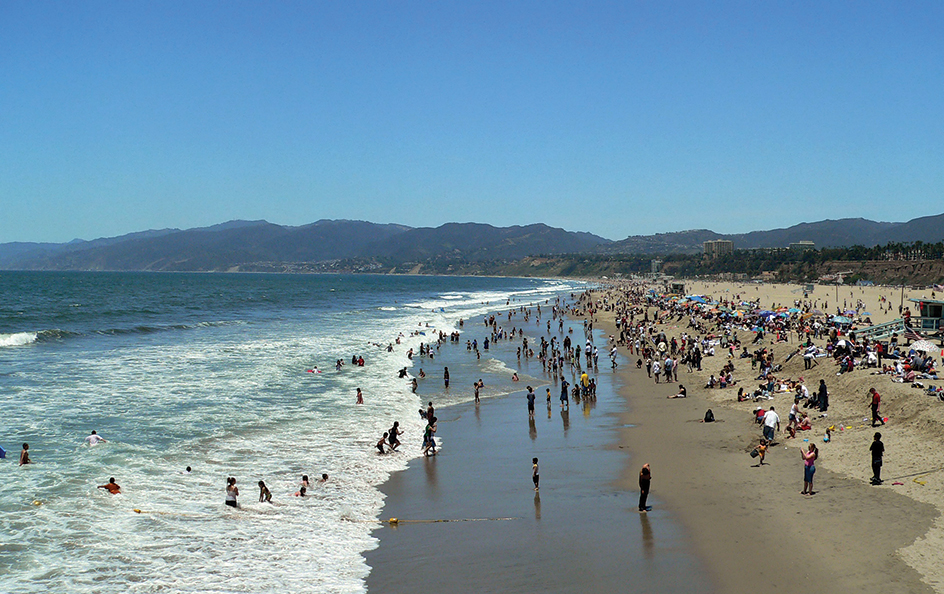
Beaches
offer opportunities for recreation and sightseeing. Well-known beaches in the Los Angeles area include Malibu, Redondo, Santa Monica, and Venice.
Farmers Market
is near Hollywood. This shopping center consists of dozens of stores and stalls that sell a wide variety of goods from alfalfa juice to Hawaiian sportswear.
La Brea tar pits,
in Hancock Park east of Beverly Hills, contain the bones of thousands of animals that were trapped in layers of oil and tar during prehistoric times. Life-sized statues of the trapped animals are exhibited. A museum on the site exhibits bones that have been dug up from the pits. See La Brea tar pits.
Spanish missions
are in the San Fernando Valley and in San Gabriel. These missions are among the 21 picturesque missions that were built in California by Franciscan friars during the 1700’s and early 1800’s.
Universal Studios,
in Universal City north of Hollywood, make up one of the largest movie-television studios. At Universal Studios, visitors take tours of the sets of motion pictures and television shows. There are also tours through action exhibits that are based on movies. CityWalk, a pedestrian promenade outside the studios, offers elegant shopping, restaurants, and entertainment.
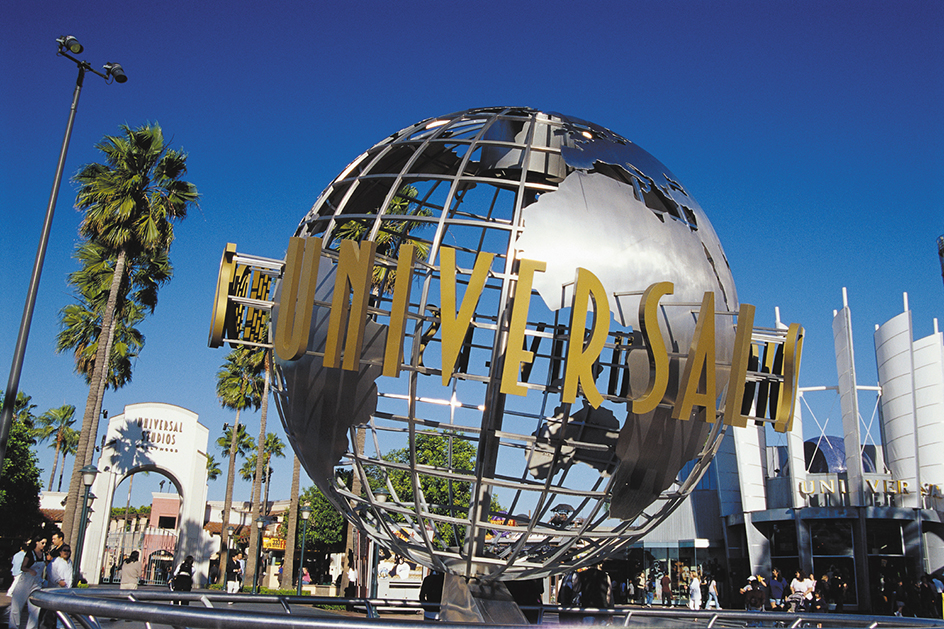
Government
Los Angeles’s government consists of a mayor, various city departments, and a 15-member City Council. The people elect the mayor to a four-year term. The mayor may not serve more than two terms. The mayor administers the government and appoints the heads of the city departments. The mayor also appoints boards of commissioners to oversee most of the departments.
The City Council makes the laws of Los Angeles and approves the budget, which the mayor prepares. One council member is elected from each of 15 districts in the city. Members of the City Council serve four-year terms. Council members may not serve more than three terms.
Much of the council’s work is done by its standing committees. These committees recommend legislation to the full council. The mayor can veto (reject) legislation passed by the council. However, the City Council can override (set aside) the mayor’s veto with a two-thirds majority vote of the council members present when the vote is taken.
Sources of the city’s income include the property tax, a sales tax, license fees for businesses and professionals, and aid from the state government and the federal government.
A five-member County Board of Supervisors governs Los Angeles County. The members are elected to four-year terms in district elections. The county government administers certain programs, such as air pollution control and flood control, throughout the county. It also provides government services for areas of the county that do not belong to any city.
Other government units that operate within Los Angeles include the Board of Education, which supervises the Los Angeles Unified School District; the California Department of Transportation, which controls the construction of freeways in the area; the California Highway Patrol, which polices the area’s freeways; and the Los Angeles County Metropolitan Transportation Authority, which operates the area’s public transportation system.
History
Native Americans were the first people to live in what is now the Los Angeles area. During the 1500’s, a branch of the Shoshone people lived in a village called Yang-na. The village lay along the Los Angeles River near what is now the downtown area.
Exploration.
In 1542, Juan Rodríguez Cabrillo, a Portuguese explorer working for Spain, discovered Yang-na. Cabrillo noted the village on his map and then continued exploring the California coast.
No other explorers reported visiting the Los Angeles area until 1769. That year, Gaspar de Portolá, a Spanish Army captain, and Juan Crespi, a Franciscan priest, led an expedition from San Diego north to Monterey Bay. After the group reached Yang-na, Crespi wrote in his diary that the area was a “delightful place” and that it had all the features necessary for a large settlement. Crespi and Portolá named the area Nuestra Señora la Reina de Los Ángeles de Porciúncula, meaning Our Lady the Queen of the Angels of Porciúncula. Porciúncula was a Roman Catholic chapel in Italy associated with Saint Francis of Assisi, the founder of the Franciscan order.
Settlement.
Soon after the Portolá party left the site of Los Angeles, Spain began its efforts to colonize the area. The first step was to establish a mission there. In 1771, Franciscan priests built Mission San Gabriel Arcángel, just east of the future city of Los Angeles. The mission was one of 21 that the Franciscans built on and near the California coast. San Gabriel became an important agricultural, cultural, and religious center.
After San Gabriel was built, Felipe de Neve, the Spanish governor of California, selected Crespi’s “delightful place” as the site for a new pueblo (town). De Neve sent soldiers into northern Mexico to offer free land, animals, tools, and money to anyone willing to move to the new settlement.
In February 1781, a group of pioneers gathered at Guaymas, Mexico, to begin the long journey to Los Angeles. They arrived on Sept. 4, 1781, and officially founded the Pueblo of Los Angeles. The settlers totaled 44 people—11 men, 11 women, and 22 children. The group consisted of Native Americans, Spaniards, and people of African and mixed ancestry.
Mexican rule.
Los Angeles grew quickly, and by 1800 it had 315 residents. The town began as a farming community, but it soon became a cattle-raising center. Much of the land in the area was divided into huge ranches on which thousands of longhorns were raised. In 1821, Mexico gained its independence from Spain and took control of Los Angeles and the rest of California.
Under Mexican rule, Los Angeles and Monterey alternated as the capital of California. In 1826, Jedediah Smith, an American fur trapper, became the first white person to reach Los Angeles by land from the East. In 1841, the first group of overland settlers from the United States arrived in the area. Other groups soon followed. But Mexicans and Spaniards continued to make up most of Los Angeles’s population.
War broke out between Mexico and the United States in May 1846. In August, U.S. troops captured Los Angeles. But the people rebelled, and the Americans were forced to leave the city in October. The United States recaptured the city in January 1847. Mexico lost the war and signed the Treaty of Guadalupe Hidalgo with the United States in 1848. Under the terms of the treaty, Mexico gave the California area to the United States.
Development and growth.
On April 4, 1850, Los Angeles was incorporated as a city. Five months later, California became a state of the United States. Los Angeles had a population of 1,610 in 1850. The city grew rather slowly during the next 20 years. It had 4,385 people in 1860 and 5,728 in 1870. But with the coming of the railroads, Los Angeles’s population soared.
In 1876, the Southern Pacific Railroad (now part of the Union Pacific Railroad) was completed between Los Angeles and San Francisco. It provided the city with a rail link to the rest of the United States through San Francisco. In 1885, the Atchison, Topeka and Santa Fe Railway (now the Burlington Northern Santa Fe Railway) provided a direct connection between the Los Angeles area and the Midwest. Competition between the Southern Pacific and the Atchison, Topeka and Santa Fe led to lower and lower fares, which brought more and more people to Los Angeles. In the spring of 1886, the fare from the Midwest to Los Angeles dropped to $1. Trainloads of people from the East and Midwest came to Los Angeles. The Los Angeles area, in turn, shipped trainloads of oranges and other farm products to the Midwest and East. By 1890, the city’s population had climbed to more than 50,000. By 1900, the population had soared to more than 100,000.
In 1899, Los Angeles began to build a huge artificial harbor at San Pedro. The harbor was completed in 1914, the same year the Panama Canal was completed. Los Angeles quickly became a major seaport.
By the 1920’s, tourism had become a big business in Los Angeles. Many tourists liked the climate so much they decided to become residents. The area’s new motion-picture industry was booming. The oil industry, which had begun in the 1890’s, was spurred by the discovery of rich new fields. Also during the 1920’s, new aircraft plants opened, and factories began to manufacture furniture, pottery, tires, and other products.
The mid-1900’s.
Los Angeles’s economy slumped during the Great Depression of the 1930’s. But its population continued to grow as thousands of jobless and homeless people drifted into the area, hoping their luck would change. The city’s economy recovered and reached new heights after the United States entered World War II in 1941. Hundreds of thousands of new residents flocked to the city to work in aircraft factories, shipyards, and other war plants. By the war’s end in 1945, Los Angeles had more than 11/2 million people.
Los Angeles’s spectacular population growth continued after World War II. Thousands of new homes were built and quickly covered the city’s open spaces. By 1960, the population had risen to nearly 21/2 million.
Recent developments.
Los Angeles today is a huge, thriving urban center. Its population is continuing to grow. But like other large cities, Los Angeles faces many problems. Periodic economic slumps occur. Unemployment is high among Black and Hispanic people, and the city has had racial and ethnic conflicts and gang violence. See the Social problems section of this article.
Air pollution has been a serious problem in Los Angeles since the 1950’s. On calm days, smoke from factories and exhaust fumes from automobiles collect near the ground and form a thick yellow haze called smog. Smog irritates the eyes and lungs and can kill plants. In 1989, a 20-year plan was adopted to reduce air pollution. The plan calls for restrictions on the use of gasoline-powered motor vehicles and on the amount of air pollutants in such products as paint and aerosol sprays.
Los Angeles also has a serious traffic problem. Most people commute in automobiles on the freeways because the city has limited public transportation. As a result, the freeways are often jammed. To help reduce congestion, Los Angeles has improved its bus service and begun a mass-transit rail system.
Since the early 1900’s, Los Angeles has had to obtain huge amounts of water from distant places by way of aqueducts. The California Aqueduct, completed in 1973, brings water to Los Angeles from California’s Sacramento Valley, 685 miles (1,102 kilometers) to the north. The city has passed various water conservation measures since the late 1980’s.
In 1973, Tom Bradley, a member of the City Council, was elected mayor of Los Angeles. He became the city’s first African American mayor. Bradley was reelected in 1977, 1981, 1985, and 1989. He chose not to run for a sixth term as mayor.
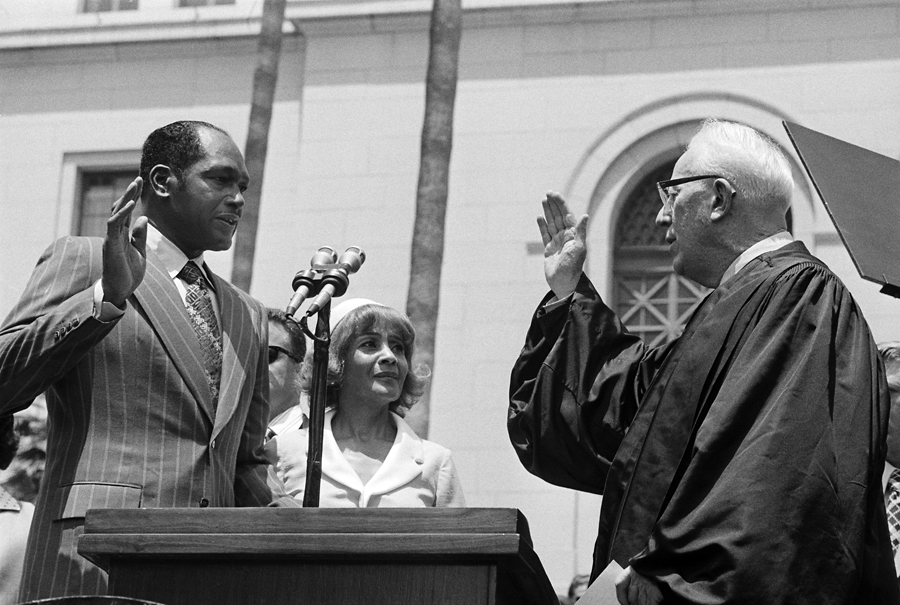
In the early 1990’s, police brutality and race relations became major concerns in Los Angeles. The most publicized incident involved Rodney G. King. King, a Black motorist, was stopped after a pursuit and beaten by four white police officers in Los Angeles in 1991. The officers faced several criminal charges, including assault. Although the beating was recorded on videotape, a state jury in 1992 acquitted (found not guilty) the four officers on all charges except one, which was later dropped. The trial was held in Simi Valley, a mainly white suburb of Los Angeles. No Black people served on the jury. The verdict set off several days of rioting, mainly in Black areas of South Los Angeles (then called South-Central Los Angeles). The rioting resulted in 53 deaths, over 4,000 injuries, and about $1 billion in property damage.
In 1993, a federal jury convicted two of the officers of violating King’s civil rights. They were each sentenced to 21/2 years in prison. The other two officers were acquitted of all charges. In a civil lawsuit in 1994, another federal jury ordered the city of Los Angeles to pay King about $33/4 million in damages.
During the 1992 riots, Reginald Denny, a white truck driver, was pulled from his truck and severely beaten by rioters. The beating was captured on videotape. Seven Black men were arrested in connection with the beating. Three pleaded either guilty or no contest to various charges. One of them received a three-year prison term, and two received two years. One of the other men was convicted of felony mayhem on Denny and of assaulting four other victims. He was sentenced to 10 years in prison. The three others were convicted of lesser charges and were sentenced to probation and community service.
Brush fires have plagued the Los Angeles area because it receives little rain. The area’s long, dry summers turn the brush and grass in the hills around the city dry and brown, creating a severe fire hazard in the early fall. In 1961, brush fires swept through the Bel Air and Brentwood communities, destroying about 450 homes. In 1993, fires broke out in the Los Angeles suburbs of Altadena and Laguna Beach, and in the Calabasas, Malibu, and Topanga Canyon areas just west of Los Angeles. The fires killed 4 people and destroyed about 1,100 buildings in these and other nearby communities.
The city and its suburbs lie on an unstable part of the earth’s crust. As a result, earthquakes sometimes occur. Most cause limited damage. But in 1971, an earthquake centered in San Fernando, just north of Los Angeles, caused 58 deaths and $511 million in property damage. In 1987, an earthquake centered in Whittier, east of the city, caused 8 deaths and $358 million in damage. In January 1994, a strong earthquake struck Los Angeles. It centered within the city limits—in the Northridge area of the San Fernando Valley section. It was the most powerful earthquake in the city’s history. It caused 57 deaths. Damage estimates ranged above $20 billion. Sections of major freeways collapsed during the earthquake, and were closed down for several months.
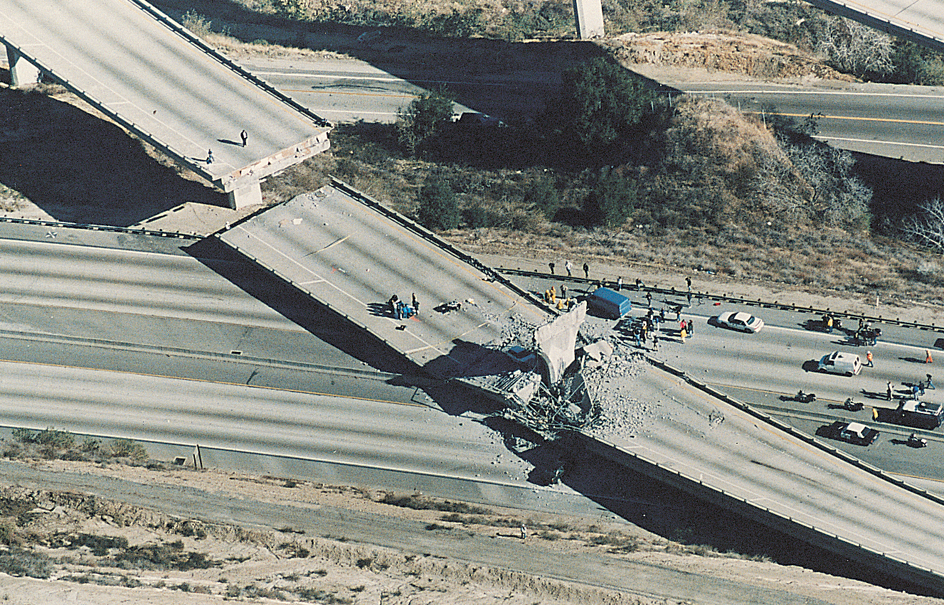
In January 1995 and again in March, powerful storms caused flooding in the Los Angeles area and other parts of California. The storms created widespread damage, much of it resulting from mudslides.
In 1999, voters approved a new city charter, which took effect in 2000. The charter expanded the mayor’s powers, streamlined city departments, and increased local participation in government.
In 2002, a number of citizens in Hollywood and in the San Fernando Valley began campaigning for those districts to secede (withdraw) from Los Angeles and become independent cities. Secession supporters in each district argued that their community’s needs were being overlooked by Los Angeles leaders. In June, the Los Angeles County Board of Supervisors placed secession referendums on the ballots for the citywide election scheduled for November. To pass, the referendums required the approval of a majority of Los Angeles voters. In the November election, the referendums failed to receive the required percentage of votes.
In 2005, Los Angeles voters elected Antonio R. Villaraigosa to become the city’s first Hispanic mayor since the 1870’s. He was reelected in 2009. In 2013, Eric Garcetti was elected to succeed Villaraigosa. Garcetti won reelection in 2017. In 2022, Karen Bass, a member of the U.S. House of Representatives, became the first woman elected mayor of the city.
In May 2007, wildfires swept through Griffith Park, northeast of Hollywood. The fires, fueled by dry brush and high winds, burned about 20 percent of the park. City workers replanted vegetation in the affected areas to prevent erosion and landslides. In December 2017, a number of wildfires burned areas in and around Los Angeles. Fires burned in the city’s Bel-Air neighborhood. Fires later burned hundreds of thousands of acres in Santa Barbara and Ventura counties to the city’s northwest. Hundreds of thousands of people were forced to evacuate their neighborhoods. In November 2018, the Woolsey fire burned in and near the cities of Malibu and Thousand Oaks, west of Los Angeles. Hundreds of homes were destroyed in the fire. Numerous fires also occurred in the Los Angeles area in 2019, 2020, and 2021.
